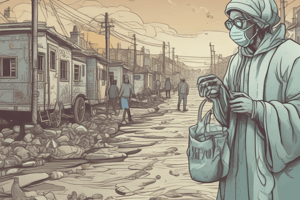Podcast
Questions and Answers
Which demographic is most susceptible to cholera?
Which demographic is most susceptible to cholera?
- Pregnant women
- Elderly adults
- Healthy teenagers
- Children under five years (correct)
What is the primary route of transmission for cholera?
What is the primary route of transmission for cholera?
- Direct contact with infected individuals
- Fecal-oral route (correct)
- Respiratory droplets
- Blood transfusion
What is the main treatment for cholera?
What is the main treatment for cholera?
- Surgery
- Physical therapy
- Oral rehydration solution or intravenous treatment (correct)
- Antibiotics only
How long can a person with cholera last without water before facing severe consequences?
How long can a person with cholera last without water before facing severe consequences?
What common side effect can occur due to antibiotic treatment for cholera?
What common side effect can occur due to antibiotic treatment for cholera?
How long does it typically take for symptoms of mild cholera to resolve on their own?
How long does it typically take for symptoms of mild cholera to resolve on their own?
What preventive measure is recommended for travelers to areas with active cholera transmission?
What preventive measure is recommended for travelers to areas with active cholera transmission?
Which of the following is NOT a method of preventing cholera?
Which of the following is NOT a method of preventing cholera?
What is the first step in the process of haemostasis?
What is the first step in the process of haemostasis?
What role does thrombin play in the coagulation cascade?
What role does thrombin play in the coagulation cascade?
What is the final structure that forms to effectively stop bleeding?
What is the final structure that forms to effectively stop bleeding?
Which of the following best describes bacillary dysentery?
Which of the following best describes bacillary dysentery?
Which component of blood analysis is measured to assess the concentration of red blood cells?
Which component of blood analysis is measured to assess the concentration of red blood cells?
What sequence accurately represents the coagulation cascade starting with factor X?
What sequence accurately represents the coagulation cascade starting with factor X?
Which type of dysentery is caused by a parasitic amoeba?
Which type of dysentery is caused by a parasitic amoeba?
Which function of blood is focused on the transportation of essential substances?
Which function of blood is focused on the transportation of essential substances?
What is the primary role of platelets during the hemostasis stage of wound healing?
What is the primary role of platelets during the hemostasis stage of wound healing?
Which chemical is released by damaged tissues to initiate the inflammation stage of wound healing?
Which chemical is released by damaged tissues to initiate the inflammation stage of wound healing?
During the proliferation phase of wound healing, what do fibroblasts primarily contribute?
During the proliferation phase of wound healing, what do fibroblasts primarily contribute?
What happens to collagen during the remodeling phase of wound healing?
What happens to collagen during the remodeling phase of wound healing?
How do bacteria contribute to delaying wound healing?
How do bacteria contribute to delaying wound healing?
What is one effect of antibiotics on wound healing?
What is one effect of antibiotics on wound healing?
Which stage of wound healing involves the maturation of collagen and strengthening of new tissue?
Which stage of wound healing involves the maturation of collagen and strengthening of new tissue?
What role do prostaglandins play during the hemostasis phase?
What role do prostaglandins play during the hemostasis phase?
Flashcards
Hemostasis
Hemostasis
The process of stopping bleeding by clotting.
Inflammation
Inflammation
The initial response to injury, marked by redness, warmth, swelling, and pain.
Proliferation
Proliferation
The stage where new tissue is built, involving fibroblasts producing collagen and forming a scar.
Remodeling
Remodeling
Signup and view all the flashcards
How does a wound lead to bacterial infection?
How does a wound lead to bacterial infection?
Signup and view all the flashcards
How do antibiotics help wound healing?
How do antibiotics help wound healing?
Signup and view all the flashcards
Histamine
Histamine
Signup and view all the flashcards
Fibroblasts
Fibroblasts
Signup and view all the flashcards
Cholera Vaccine
Cholera Vaccine
Signup and view all the flashcards
Children and Cholera
Children and Cholera
Signup and view all the flashcards
Cholera Recovery Time
Cholera Recovery Time
Signup and view all the flashcards
Oral Rehydration Solution (ORS)
Oral Rehydration Solution (ORS)
Signup and view all the flashcards
Flagellated Cells
Flagellated Cells
Signup and view all the flashcards
Ciliated Cells
Ciliated Cells
Signup and view all the flashcards
Microbes
Microbes
Signup and view all the flashcards
Motile
Motile
Signup and view all the flashcards
Platelets
Platelets
Signup and view all the flashcards
Coagulation Cascade
Coagulation Cascade
Signup and view all the flashcards
Fibrin Clot
Fibrin Clot
Signup and view all the flashcards
Bacillary Dysentery
Bacillary Dysentery
Signup and view all the flashcards
Amoebic Dysentery
Amoebic Dysentery
Signup and view all the flashcards
Blood Analysis
Blood Analysis
Signup and view all the flashcards
Hemoglobin
Hemoglobin
Signup and view all the flashcards
Study Notes
EBL Semester 1 Notes
- Course material covers Cholera, microbes, antibiotics, blood, malaria, nutrition, and muscles/energy.
- Vocabulary includes terms like centrifuges, cholera, epidemic, pandemic, endemic, mannitol, autoclave, pipettes, rehydration salts, flagellated cells, ciliated cells, microbes, motile, ecology, haemocytometer, stethoscope, dysentery, differential count, blood smear, intravenous, venepuncture, malaria, ebola, pre-albumin, anaemia, hypocalcaemic, rachitic rosary, folate, ferritin, electromyography, muscle biopsy, Doppler ultrasound, McArdle syndrome, and more.
- Case studies and learning objectives (ILOs) are included for each topic.
- Important concepts include the function and effects of Cholera, electrolyte balance, treatment options, demographics affected, and methods of transmission.
- The study of microbes, their structures, and the process of contamination is emphasized.
- The role of different types of microorganisms, staining techniques, presence in water, filtration methods, and fluoridation processes are discussed.
- The functions of blood, its components, blood analysis (blood smears, counts, and differential counts related to infections), infection spreading and prevention, and blood handling precautions are detailed.
- Malaria's structure, lifecycle, spread, symptoms, treatment, demographics, pathology, and methods for drawing blood are covered, including associated complications.
- Essential information on nutrition, such as the digestive system's anatomy and physiology (including enzymes), vitamins' importance and functions, minerals, healthy diets, malnutrition, rickets, and types of diets are covered, with specific focus on feeding a child.
- There is content around muscle physiology and function, including types of muscles, energy consumption through aerobic and anaerobic respiration, muscle contraction mechanisms, enzyme roles, and muscle-related disorders (McArdle syndrome) along with relevant diagnostic tests (MRI, electromyography, muscle biopsy).
- Cardiovascular system physiology, including the anatomy of the heart, cardiac cycle, circulatory system, effects of exercise on the heart, cardiac output, blood pressure and its normal ranges, autonomic nervous systems' functions, and diagnostic testing (ECG, echocardiogram) are included, focusing on cardiovascular diseases and symptoms.
Studying That Suits You
Use AI to generate personalized quizzes and flashcards to suit your learning preferences.





